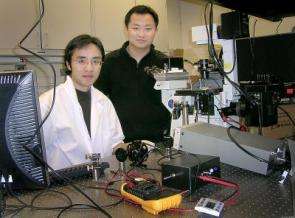The power of one: A simpler, cheaper method for cell fusion

It's not easy to make one plus one equal one. But biological engineer Chang Lu has done just that with a new and cheaper method to electrically fuse cells - a vital technology for studying stem cells, creating clones and finding disease antibodies.
"The only current method for electrofusion requires a very expensive and specialized electrical pulse generator," said Lu, a professor of agricultural and biological engineering at Purdue University. "My device uses constant DC voltage and would enable researchers to fuse one pair of cells at a time."
Electrofusion - the process of using electric shocks to fuse two or more living cells - is a growing technology with a wide variety of applications in research, biotechnology and medicine. The technique is integral to stem cell research, where it affords researchers greater insight into how genes guide protein synthesis. It also may be used to create large quantities of different disease-specific antibodies and has helped scientists clone mammals.
The current technique for electrofusion requires a pricey electrical pulse-generator, which could cost as much as $13,000. Lu's technology, on the other hand, uses a $100 DC power supply, which, unlike the specialized generator, can be used to power other laboratory equipment. And because of its microscale dimensions, Lu said his technology requires significantly smaller sample volumes.
"This could be very important," he said. "For example, if you had to supply cells from your own body or from another live organism, you would want to take as few as possible."
Lu's device consists of fluid-filled channels inside a tiny microchip. Prior to fusion, cells are engineered to bond to one another by using a minor chemical treatment. Cells are first placed in an aqueous chamber within the chip, where they pair off. In contact with one another but not yet fused, the cells flow towards the only exit, which is a miniscule gap that channels electricity from one pole to the other. Passing through this narrow section, cells are subjected to a strong electrical field that causes them to become destabilized and fuse together.
In one of electrofusion's applications, scientists can fuse antibody-producing cells from the spleen (beta cells) with cancer cells in order to create a virtually immortal, antibody-producing hybrid, called a hybridoma. By manipulating the beta cells prior to fusion, scientists can create thousands of different hybridomas that produce antibodies effective against different viruses and diseases like cancer.
Lu's research regarding the development and use of this technology was published online Monday (Dec. 4) in the journal Applied Physics Letters and is scheduled to appear in print later this month. Graduate student Jun Wang was a co-author.
One downside to the current technique for electrofusion is that researchers have relatively little control over how many cells they fuse at once; the technique works by aligning an uncertain number of cells along an electrical field before zapping them with pulses of electricity. Lu's technology is more precise.
"In my device, the narrow section in the microfluidic channel is so small that only two to three cells fit into it," Lu said.
Lu said he believes that his device may be developed to have a higher throughput than current methods. Although Lu's technology currently fuses single pairs at once, it may be expanded so that multiple devices simultaneously fuse cells in parallel.
"In time, this could drastically increase the rate of cell fusion," he said.
Lu has shown that his technology has a success rate comparable to current technology; about 30 percent to 40 percent of the cells are properly fused when the operational parameters were tuned up.
"We are not saying that our technology is necessarily better, but it is definitely cheaper and has other benefits," he said. "Hopefully, with our technology many more scientists will be able to experiment with the procedure. I believe that could open up a lot of exciting research opportunities."
Lu demonstrated the efficacy of his device using Chinese hamster ovary cells, which were chemically engineered to link prior to fusion. He said his technology could be developed to fuse different types of cells in the future.
Source: Purdue University















